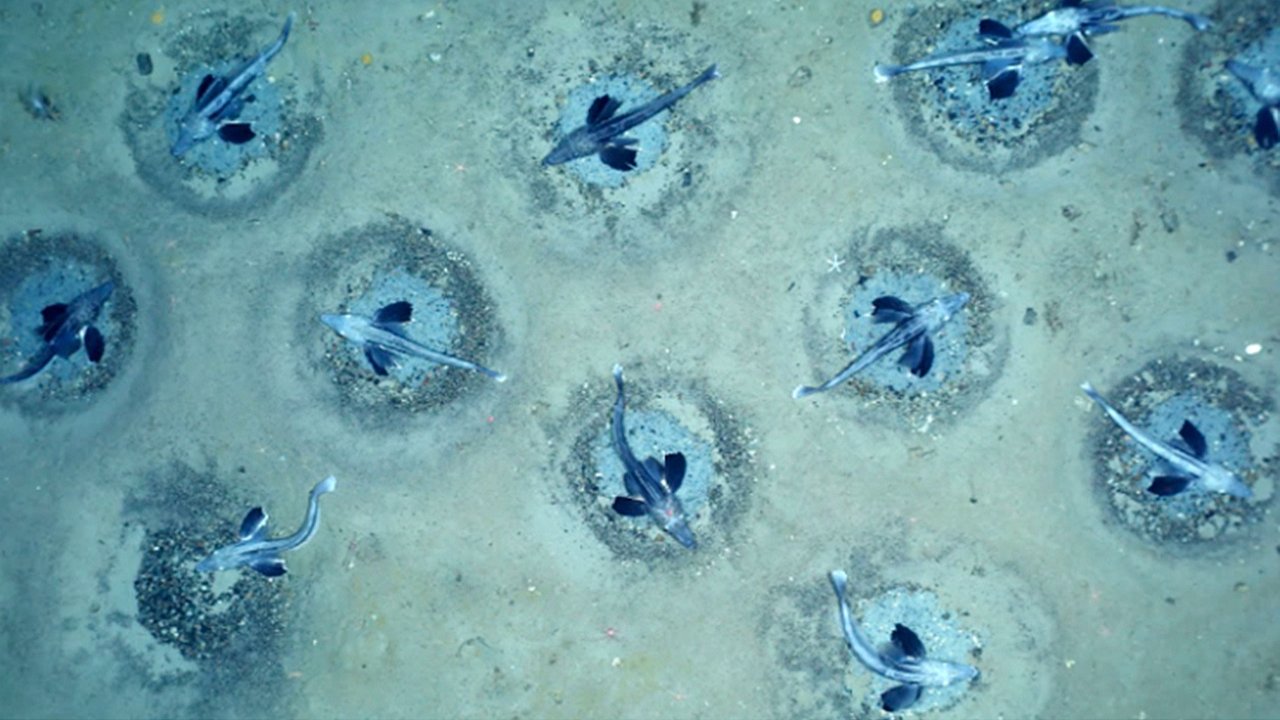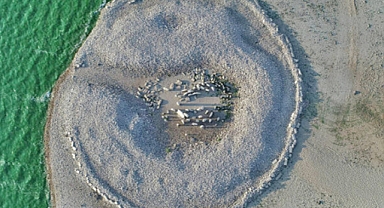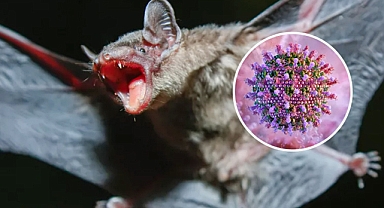The mysterious depths of Earth’s oceans continue to yield breathtaking discoveries. Recently, researchers stumbled upon an extraordinary find beneath the icy expanse of Antarctica’s Weddell Sea: the world’s largest contiguous fish breeding colony. Situated 500 meters below the sea ice, this sprawling habitat spans 240 square kilometers and contains an estimated 60 million active nests of Jonah’s icefish (Neopagetopsis ionah).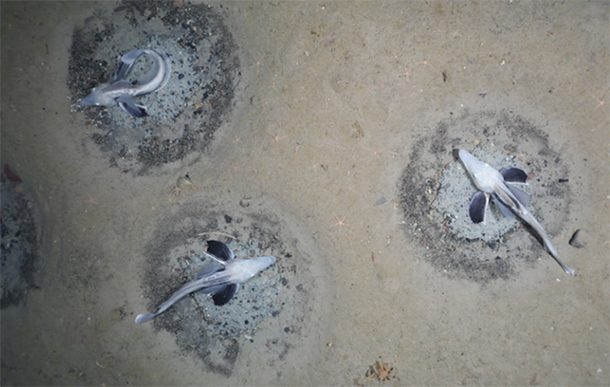 Image credit: Alfred Wegener Institute, PS124 OFOBS TeamThe groundbreaking study, published in Current Biology, was conducted by a team aboard the German research vessel Polarstern. Using advanced towed camera systems, the scientists observed the nests, each housing 1,000–2,000 eggs and guarded by adult icefish. The sheer scale of the site is unprecedented, as previous records of fish nesting sites showed only a few dozen nests clustered together.“This enormous breeding ground is an incredible and unexpected discovery,” said Autun Purser, deep-sea biologist at the Alfred Wegener Institute in Germany and lead author of the study. “The idea that such a vast colony went undetected for so long is astonishing.”Unique Characteristics of Jonah’s Icefish
Image credit: Alfred Wegener Institute, PS124 OFOBS TeamThe groundbreaking study, published in Current Biology, was conducted by a team aboard the German research vessel Polarstern. Using advanced towed camera systems, the scientists observed the nests, each housing 1,000–2,000 eggs and guarded by adult icefish. The sheer scale of the site is unprecedented, as previous records of fish nesting sites showed only a few dozen nests clustered together.“This enormous breeding ground is an incredible and unexpected discovery,” said Autun Purser, deep-sea biologist at the Alfred Wegener Institute in Germany and lead author of the study. “The idea that such a vast colony went undetected for so long is astonishing.”Unique Characteristics of Jonah’s Icefish
Jonah’s icefish stand out in the animal kingdom for several reasons. These fish lack red blood cells and hemoglobin, giving their blood a translucent, white appearance. Instead, their survival in the frigid waters of Antarctica is enabled by a protein-based antifreeze in their blood, allowing them to thrive in conditions that would be lethal to most species.The newly discovered breeding site is as large as the island of Malta, with each nest spaced roughly three meters apart. Oceanographic data suggests that the area’s suitability for nesting is due to an inflow of slightly warmer deep water, creating an ideal environment for icefish reproduction.A Critical Ecosystem Worth Protecting
The biomass of the breeding colony is estimated at an astonishing 60,000 tons, drawing predators like Weddell seals that rely on the abundant resources. This highlights the crucial role the site plays in the Antarctic ecosystem.Despite its ecological significance, the area remains vulnerable. A Marine Protected Area (MPA) for the Weddell Sea has been under discussion by the European Union and the Commission for the Conservation of Antarctic Marine Living Resources (CCAMLR) since 2016 but has yet to be finalized.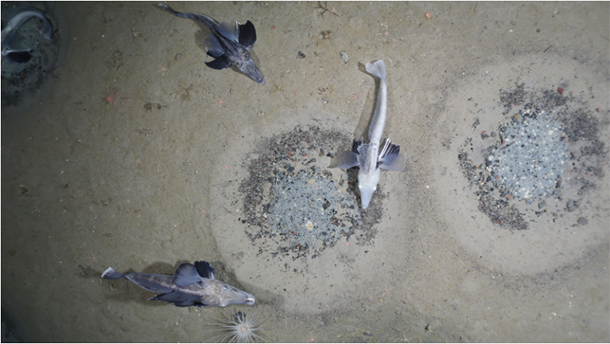 The ice babies in the nests may soon get their own marine protected area. Image credit: Alfred Wegener Institute, PS124 OFOBS Team“This discovery underscores the urgency of protecting this region,” said Professor Antje Boetius, a deep-sea biologist and director at the Alfred Wegener Institute. Boetius contributed to the development of non-invasive technologies used to document the site. “Now that we know the exact location of this extraordinary breeding colony, CCAMLR members must act to ensure that no fishing occurs here and that only non-invasive research is permitted.”The Bigger Picture
The ice babies in the nests may soon get their own marine protected area. Image credit: Alfred Wegener Institute, PS124 OFOBS Team“This discovery underscores the urgency of protecting this region,” said Professor Antje Boetius, a deep-sea biologist and director at the Alfred Wegener Institute. Boetius contributed to the development of non-invasive technologies used to document the site. “Now that we know the exact location of this extraordinary breeding colony, CCAMLR members must act to ensure that no fishing occurs here and that only non-invasive research is permitted.”The Bigger Picture
While the Weddell Sea remains one of the least explored marine environments, the discovery of this massive icefish breeding site serves as a stark reminder of the importance of preserving fragile ecosystems. International cooperation is critical to protect this biodiversity hotspot and ensure the survival of species uniquely adapted to life beneath the Antarctic ice.
 Image credit: Alfred Wegener Institute, PS124 OFOBS TeamThe groundbreaking study, published in Current Biology, was conducted by a team aboard the German research vessel Polarstern. Using advanced towed camera systems, the scientists observed the nests, each housing 1,000–2,000 eggs and guarded by adult icefish. The sheer scale of the site is unprecedented, as previous records of fish nesting sites showed only a few dozen nests clustered together.“This enormous breeding ground is an incredible and unexpected discovery,” said Autun Purser, deep-sea biologist at the Alfred Wegener Institute in Germany and lead author of the study. “The idea that such a vast colony went undetected for so long is astonishing.”Unique Characteristics of Jonah’s Icefish
Image credit: Alfred Wegener Institute, PS124 OFOBS TeamThe groundbreaking study, published in Current Biology, was conducted by a team aboard the German research vessel Polarstern. Using advanced towed camera systems, the scientists observed the nests, each housing 1,000–2,000 eggs and guarded by adult icefish. The sheer scale of the site is unprecedented, as previous records of fish nesting sites showed only a few dozen nests clustered together.“This enormous breeding ground is an incredible and unexpected discovery,” said Autun Purser, deep-sea biologist at the Alfred Wegener Institute in Germany and lead author of the study. “The idea that such a vast colony went undetected for so long is astonishing.”Unique Characteristics of Jonah’s IcefishJonah’s icefish stand out in the animal kingdom for several reasons. These fish lack red blood cells and hemoglobin, giving their blood a translucent, white appearance. Instead, their survival in the frigid waters of Antarctica is enabled by a protein-based antifreeze in their blood, allowing them to thrive in conditions that would be lethal to most species.The newly discovered breeding site is as large as the island of Malta, with each nest spaced roughly three meters apart. Oceanographic data suggests that the area’s suitability for nesting is due to an inflow of slightly warmer deep water, creating an ideal environment for icefish reproduction.A Critical Ecosystem Worth Protecting
The biomass of the breeding colony is estimated at an astonishing 60,000 tons, drawing predators like Weddell seals that rely on the abundant resources. This highlights the crucial role the site plays in the Antarctic ecosystem.Despite its ecological significance, the area remains vulnerable. A Marine Protected Area (MPA) for the Weddell Sea has been under discussion by the European Union and the Commission for the Conservation of Antarctic Marine Living Resources (CCAMLR) since 2016 but has yet to be finalized.
 The ice babies in the nests may soon get their own marine protected area. Image credit: Alfred Wegener Institute, PS124 OFOBS Team“This discovery underscores the urgency of protecting this region,” said Professor Antje Boetius, a deep-sea biologist and director at the Alfred Wegener Institute. Boetius contributed to the development of non-invasive technologies used to document the site. “Now that we know the exact location of this extraordinary breeding colony, CCAMLR members must act to ensure that no fishing occurs here and that only non-invasive research is permitted.”The Bigger Picture
The ice babies in the nests may soon get their own marine protected area. Image credit: Alfred Wegener Institute, PS124 OFOBS Team“This discovery underscores the urgency of protecting this region,” said Professor Antje Boetius, a deep-sea biologist and director at the Alfred Wegener Institute. Boetius contributed to the development of non-invasive technologies used to document the site. “Now that we know the exact location of this extraordinary breeding colony, CCAMLR members must act to ensure that no fishing occurs here and that only non-invasive research is permitted.”The Bigger PictureWhile the Weddell Sea remains one of the least explored marine environments, the discovery of this massive icefish breeding site serves as a stark reminder of the importance of preserving fragile ecosystems. International cooperation is critical to protect this biodiversity hotspot and ensure the survival of species uniquely adapted to life beneath the Antarctic ice.
